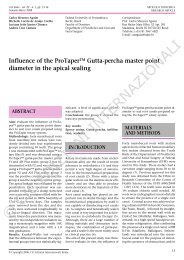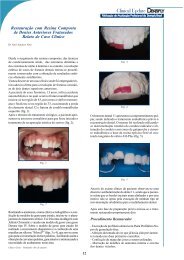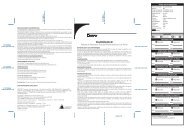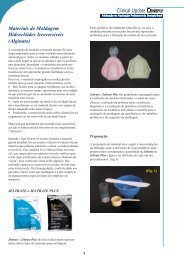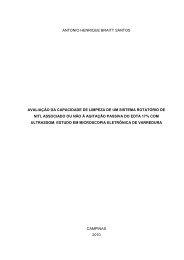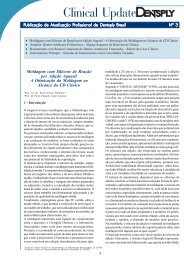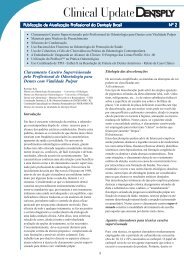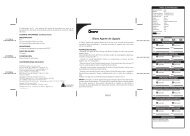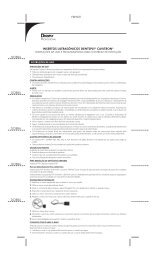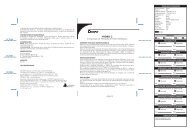Create successful ePaper yourself
Turn your PDF publications into a flip-book with our unique Google optimized e-Paper software.
Blunk/Zaslansky<br />
many of the products, change the rank between the initial<br />
water storage period, as compared with the rank after the<br />
first year . We are aware that such ranking might be of limited<br />
use for predicting clinical performance; therefore, clinicians<br />
and manufacturers might need to define criteria for<br />
“adequate performance”, not “better performance”. Clearly<br />
such long-term effects need to be considered in addition to<br />
operation skill and experience, 15,21 both of which are difficult<br />
to account for, therefore consequences of these findings<br />
necessitate further investigations.<br />
The marginal analysis centered on the quantitative evaluation<br />
of MQ1 (“excellent” or “continuous” margin) as a<br />
measure for marginal integrity. It has recently been shown<br />
that such an evaluation provides a good indicator for the<br />
ability of an adhesive system to compensate for the shrinkage<br />
of composite resins during polymerization, as compared<br />
to bond strength tests. 17 The extent to which the present in<br />
vitro results correspond to in vivo data of quantitative marginal<br />
analysis of Class V fillings is not obvious, especially as<br />
there are reports showing that such data are unable to predict<br />
clinical outcome. 17 Nevertheless, results of this study<br />
and trend analysis provide an additional means of determining<br />
objective and standard measures of the physical attributes<br />
of any combination of adhesive system and composites.<br />
It therefore remains to be seen just how such details<br />
match the outcomes of clinical investigations. It is worthwhile<br />
to note that other studies have evaluated the marginal<br />
quality using stress induced by mechanical loading. 12,13<br />
The method employed in this study has the advantage that<br />
TC induces precise and repeatable stress (assuming the coefficient<br />
of thermal expansion of the composites stays constant),<br />
and this concept was used to provide more information<br />
about the effects of water storage at short and long intervals.<br />
The present results are based on SEM evaluation of the<br />
percentage of the different marginal qualities, calculated in<br />
relation to the entire margin length in dentin or enamel independently.<br />
It has been shown that when the same operator<br />
evaluates the same specimens twice, the difference between<br />
the results is in the range of 4%, 26 whereas when two<br />
trained operators evaluate the same specimens, the differences<br />
can reach 10% to 20%. 18 Therefore, all specimens in<br />
this study were prepared and evaluated by the same operator.<br />
It is interesting to note that for most of the products not<br />
displaying a large discrepancy between the initial and intermediate<br />
MQ1 values, the first-year data provide only a moderate<br />
predictor for the longer term trend of deterioration.<br />
Therefore, initial predictors of restorative success have limited<br />
applicability, and more data over long periods of time<br />
are needed. This is unavoidable even in an in vivo setting,<br />
and is important especially when both manufacturers and<br />
clinicians want to know as early as possible which is the best<br />
product. It is, of course, conceivable that storage at higher<br />
temperatures might allow faster answers to these questions.<br />
All-in-one adhesives are rather user friendly; however, certain<br />
indicators have suggested reduced performance that<br />
might be associated with their usage. Compared with twostep<br />
self-etching or etch-and-rinse adhesive systems, lower<br />
bond strength values were reported. 5,14,19,20 It has also<br />
been shown that permeable membranes develop after curing<br />
due to a high hydrophilicity, which allows water movements<br />
through the all-in-one adhesive layer. 30 Sites of incomplete<br />
water removal and subsequent suboptimally polymerized<br />
resins 31 have been described and termed “water<br />
trees”. All these might contribute to extensive degradation<br />
of the adhesive layer, 7,32 but conclusive findings have not<br />
been confirmed. The most recent (to date) one-bottle all-inone<br />
adhesives appear to be susceptible to phase separation<br />
after dispensing the complex mixture of hydrophobic and hydrophilic<br />
components, 34 and this also is assumed to contribute<br />
to bond degradation. 33<br />
This study has presented preliminary results of short- and<br />
long-term water storage effects combined with thermocycling<br />
for control and 14 all-in-one adhesive/composite treatments.<br />
The results show that overall, few if any differences<br />
are found in vitro between the tested products and the reference<br />
materials. Furthermore, based on a quality estimate<br />
associated with the marginal integrity, it has been shown<br />
that early deterioration rates (up to 1 year) can only sometimes<br />
be used as estimates for the rate of bond degradation<br />
over a period of 3 years. Indeed, it seems that deterioration<br />
rates due to storage in water are not dependent on the class<br />
(or generation) of the adhesive: large differences in deterioration<br />
rates seem to exist between different products, and<br />
these are probably associated with the details of the specific<br />
chemistry. Additional studies are still needed in order to<br />
elucidate to what extent – and in which product – deterioration<br />
is critical. These should then be correlated with clinical<br />
studies so that decisive conclusions can be drawn .<br />
It appears that the effects of long-term water storage may<br />
not be as detrimental as usually assumed, if indeed the marginal<br />
integrity estimates are appropriate measures of the<br />
quality and effectiveness of recent generations of dental adhesives.<br />
A statistically significant decrease in the amount of<br />
MQ1 was only found in 3 out of 14 tested all-in-one adhesives<br />
after 1 year water storage. However, in enamel, the<br />
marginal analysis revealed fewer “continuous margins” than<br />
the control groups for G-Bond, AQ Bond, Hybrid Bond, and<br />
One-up Bond F Plus, and this was already observed after 1<br />
year of water storage.<br />
As new results of clinical evaluations emerge, and with a<br />
growing body of data from in vitro measurements, it is hoped<br />
that a clearer understanding of the long-term effects of the<br />
use of these systems will emerge, thus providing an improved<br />
guide for clinical judgement.<br />
REFERENCES<br />
1. Anusavice KJ. Criteria for selection of restorative materials: properties versus<br />
technique sensitivity. In: Anusavice KJ (ed). Quality evaluation of dental<br />
restorations. Chicago: Quintessence, 1989:15-56.<br />
2. Armstrong SR, Vargas MA, Fang Q, Laffoon JE. Microtensile bond strength<br />
of a total-etch 3-step, total-etch 2-etch, self-etch 2-step, and a self-etch 1-<br />
step dentin bonding system through 15-month water storage. J Adhes Dent<br />
2003;5:47-56.<br />
3. Armstrong SR, Vargas MA, Chung I, Pashley DH, Campbell JA, Laffoon JE,<br />
Qian F. Resin-dentin interfacial ultrastructure and microtensile dentin bond<br />
strength after five-year water storage. Oper Dent 2004;29-26:705-712.<br />
Vol 9, Supplement 1, 2007 239



